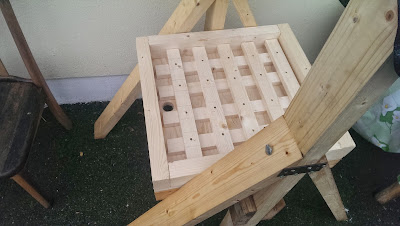 |
| Homemade demijohn |
The cider went into these under airlock to allow them to ferment out without the dead yeast cells and general sludge left after the first fermentation, affecting the flavour. I stored the bottles beside a radiator to allow them to ferment out all the sugars so I could then store them without fear of the bottles exploding.
 |
| Cider transfered into the demijohns |
 |
| Lined up beside the radiator |
Once the bubbles had stopped coming through the airlocks I knew fermentation was finished. I then waited for the cider to clear. For this they need somewhere cool. I moved them away from the radiator and they cleared in about 2 weeks.
 |
| Cleared cider |
Once clear I moved them to the attic. They will be kept cool there and they will age for a few months. I had a sneaky taste and it was very bitter. This may lessen with aging. If it doesn't mellow by the spring I will sweeten the cider using an unfermentable sugar. I had expected the cider to be quite bitter as I used mostly cooking apples so I am not too worried about that.
Next up are the blackberry and elderberry wines which I started in early October. After 4 days both wines were strained and transfered into demijohns to finish fermenting without the fruit and pulp. They both bubbled away for a few days in the demijohns. I'm not sure quite how long as I left them to ferment and clear for about a month. When I came back to check them I had two very different results.
 The blackberry wine had stopped fermenting before all the sugars had turned to alcohol. This left me with a "wine" with about 7% alcohol and it was very sweet. This is a problem with some brews known as a stuck fermentation. It has a few fixes like shaking up the brew, adding yeast nutrient and moving to a warm place. I tried all these and it had little or no effect. Sometimes fermentation stops due the high level of alcohol killing off the yeast. I had a packet of Turbo Yeast. It says it can ferment up to 20% alcohol so I have added that to the wine to see if it can ferment out the last of the sugar and give me a 13% wine with no sugar left. It is quite expensive as yeast goes. I think it cost 6 euro or so. Finger crossed it gets the job done.
The blackberry wine had stopped fermenting before all the sugars had turned to alcohol. This left me with a "wine" with about 7% alcohol and it was very sweet. This is a problem with some brews known as a stuck fermentation. It has a few fixes like shaking up the brew, adding yeast nutrient and moving to a warm place. I tried all these and it had little or no effect. Sometimes fermentation stops due the high level of alcohol killing off the yeast. I had a packet of Turbo Yeast. It says it can ferment up to 20% alcohol so I have added that to the wine to see if it can ferment out the last of the sugar and give me a 13% wine with no sugar left. It is quite expensive as yeast goes. I think it cost 6 euro or so. Finger crossed it gets the job done.The elderberry wine was much more successful. I tested a sample of the wine and it had zero sugar left in it. The percentage alcohol is about 12%. I had a sneaky taste (as I like to) and it was nice. A bit like a light red wine. Apparently elderberries have a lot of tannins in them which benefit from aging. So going by that reasoning the wine should improve with time in the bottle. That's if it lasts that long. I transfered it into wine bottles and put plastic stoppers into them. I was considering blending some of it with the blackberry wine so I haven't put proper corks in the bottles yet. Having tasted it I will definitely want to keep some unblended to age so I will be putting proper corks in some of these bottles.
That's most of the homebrew taken care of. Today I took a sample of the porter and it has pretty much fermented out and cleared so it will be ready to bottle soon. I also had a sneaky taste (have you noticed a pattern?) and it tasted lovely. Not just as a homebrew, it tasted like a good craft beer. So I am feeling optimistic about this batch. I will put up a post about bottling it when the time comes.
Until Then.












































